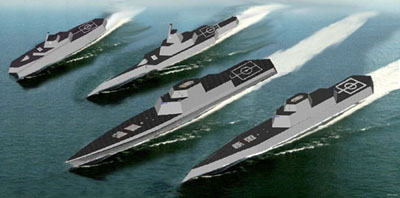




As a follow-on to the Arleigh Burke-class program, the Navy is evaluating concepts for a new generation of surface combatants that is expected to provide the future fleet with the necessary capabilities and be built in sufficient quantities to provide the required number of ships for overseas presence and war-fighting missions. The SC 21 will initially replace older ships of the SPRUANCE (DD 963) Class, and OLIVER HAZARD PERRY (FFG 7) Class.
The Twenty-First Century Surface Combatant (SC-21) Mission Need Statement (MNS) was approved by the Joint Requirements Oversight Council (JROC) in September 1994. Required capabilities called out in the MNS included: Power Projection; Battlespace Dominance; Command, Control and Surveillance; Joint Force Sustainment; Non-combat Operations; and Survivability / Mobility. In January 1995 the Defense Acquisition Board (DAB) gave approval to Milestone 0 for SC-21 Acquisition Phase 0 (Concept Exploration and Definition). A two-part Cost and Operational Effectiveness Analysis (COEA ) is being conducted. The first part: established capability of currently planned Navy surface forces (the baseline case) to accomplish primary missions through the year 2025; and identified / quantified mission deficiencies to which SC-21 designs and force structures would contribute. The second part is comparing alternative ship concepts and force structures for SC-21 using force-on-force analysis to evaluate relative effectiveness of the alternatives in joint scenarios.The Navy conducted this two-phase cost and operational effectiveness analysis, completed in 1997, to recommend design alternatives for the new ship, or family of ships, and will be followed later that year by a decision for approval to begin a new acquisition program. Contract award for construction of the lead ship is expected in the 2003-2005 time frame. A land-attack destroyer is planned as the first variant in the new family of ships, whose primary missions will be to (1) support the establishment of comprehensive battlespace dominance to protect friendly forces from enemy attack and (2) influence events ashore through the application of precision firepower.
Three preliminary ship concepts used in the first phase of the Navy�s cost and operational effectiveness analysis for the 21st Century Surface Combatant program. Each concept has a different set of capabilities and therefore a different estimated cost. The concepts are as follows:

Specifications | |